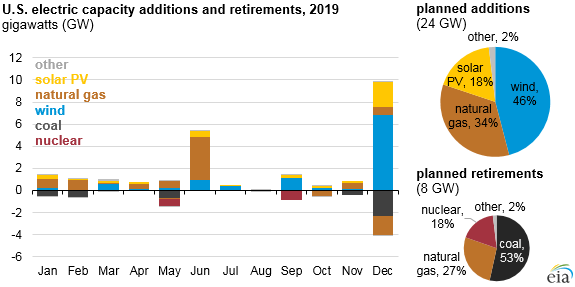
According to a new report from the U.S. Energy Information Administration (EIA), new electric generating capacity this year will come primarily from wind, solar and natural gas.
EIA’s latest inventory of electric generators estimates that 23.7 GW of new capacity additions and 8.3 GW of capacity retirements are expected for the U.S. electric power sector in 2019. The utility-scale capacity additions consist of wind (46%), natural gas (34%) and solar photovoltaics (18%), with the remaining 2% consisting primarily of other renewables and battery storage capacity.
For wind, a total of 10.9 GW of capacity is currently scheduled to come online in 2019. Most of this capacity will not come online until the end of the year, which is typical for renewable capacity, notes EIA. Three states – Texas, Iowa and Illinois – will be home to more than half of the 2019 planned wind capacity additions.
For solar, nearly half of the 4.3 GW of utility-scale electric power sector solar PV capacity additions will be located in three states: Texas, California and North Carolina. In addition to utility-scale capacity, EIA’s Short-Term Energy Outlook expects an additional 3.9 GW of small-scale solar PV capacity to enter service by the end of the year.
Lastly, for natural gas, planned capacity additions are primarily in the form of combined-cycle plants (6.1 GW) and combustion-turbine plants (1.4 GW). Most of the natural gas capacity is scheduled to be online by June 2019 in preparation for high summer demand. Of the planned natural gas capacity additions, 60% will occur in Pennsylvania, Florida and Louisiana.
Scheduled capacity retirements for 2019 primarily consist of coal (53%), natural gas (27%) and nuclear (18%), with a single hydroelectric plant in the state of Washington and other smaller renewable and petroleum capacity accounting for the remaining 2%, according to EIA.
Most of the coal retirements are scheduled to occur at the end of 2019. Half of the planned retirement capacity for coal is at a single plant, Navajo, an Arizona facility that first came online in the 1970s. The 4.5 GW of coal-fired capacity expected to retire in 2019 is relatively small compared with the estimated 13.7 GW that retired in 2018, which was the second-highest amount of coal capacity retired in a year, the agency points out.
The scheduled natural gas retirements (2.2 GW) consist mostly (2.0 GW) of steam turbine plants. The natural gas steam turbine plants that are scheduled to retire are all older units that came online in the 1950s or 1960s. Most of the retiring natural gas steam turbine capacity (1.6 GW) is located in California.
Two nuclear plants totaling 1.5 GW are currently scheduled to retire in 2019. The Pilgrim Nuclear Power Station, located in Massachusetts, is scheduled to retire in May, and the remaining unit at the Three Mile Island Power Station, located in Pennsylvania, is scheduled to retire in September.

The agency notes that the utility-scale values in the report refer to capacity reported to EIA by developers and power plant owners – respondents to EIA’s annual and monthly electric generator surveys. In the annual survey, respondents are asked to provide planned online dates for any known generators coming online in the next five years (or 10 years for coal and nuclear units). The monthly survey tracks the status of generators coming online in the coming year. Based on previous analysis of reported online dates, these values tend to be accurate within the coming 12 months, says EIA.



